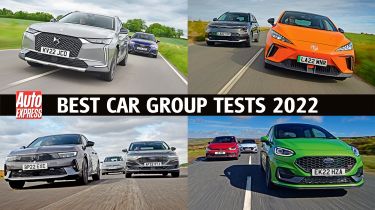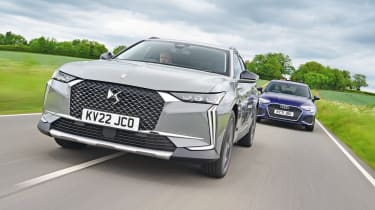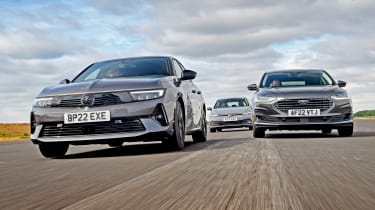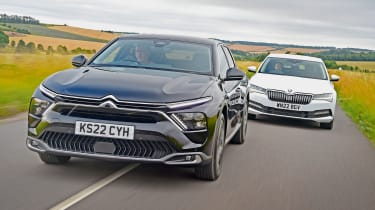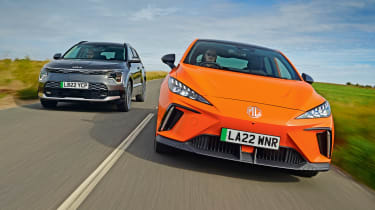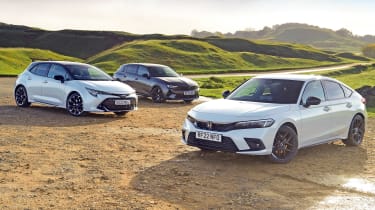Best car group tests 2022: our most memorable head-to-heads: July - November
We've pitted many cars against each other over the past year, and these are our favourite battles
July
Toyota’s first EV takes on Hyundai and Volkswagen rivals
Toyota has been a bit late to the full EV party. Partly that’s because it’s been such a champion of hybrid tech, but that delay has given it the chance to create its first purpose-built EV with the benefit of seeing how the other brands had done things. So we wanted to know how it competed.
To do this, we brought the all-new Toyota bZ4X along to meet the Hyundai Ioniq 5 and Volkswagen ID.4 EVs. In some ways, we found the Toyota to be excellent; few cars of this type deliver a sophistication to their ride and handling like the bZ4X displayed to us. Rear legroom and the infotainment system were the best of the three, but its real-world range was the lowest – although a reasonable 263 miles in the ideal conditions of our test – and the high floor compromised cabin space.
It still pipped the VW, though. We think the best of the ID.4 range lies lower down its pecking order, because the sporty GTX wasn’t any more fun to drive, didn’t feel particularly quick and was the most expensive of this trio.
In the end, the Hyundai took the win. It was comfortable, hugely spacious and came with ultra-rapid charging, which made the Ioniq 5 very easy to live with – and still does.
August
DS 4 scores shock win over Audi A3 in premium hatch duel
Issue 1,740 contained one of the shocks of 2022, when the all-new DS 4 beat the Audi A3 in our in-depth test.
Used - available now

2016 Tesla
Model S
78,000 milesAutomaticElectric
Cash £18,999
2022 Nissan
Qashqai
25,388 milesAutomaticPetrol1.3L
Cash £21,999
2024 Volkswagen
Golf Estate
8,516 milesAutomaticDiesel2.0L
Cash £27,499
2022 Nissan
Qashqai
16,923 milesAutomaticPetrol1.3L
Cash £20,999Before the DS 4 emerged, the stylish offerings from the French premium brand had undoubtedly held plenty of appeal, but only if you were willing to live with quite a few compromises. Often, they lacked the mechanical sophistication to take on the German brands, yet once monthly PCP deals were taken into account, they proved to be more expensive more often than not, too.
That all changed in this test. Against a car as capable as the A3, the DS 4 showed it was by far the most convincing model DS had yet released. It delivered genuinely impressive ride comfort, but did so without completely compromising body control. Yes, the Audi was slightly sharper to drive, but the 4 was so much more relaxing that the small compromise was definitely worthwhile.
Both hatches are prime fodder for company-car users, especially when paired with the emissions-busting plug-in hybrid powertrains used in the cars assessed. Here, the DS 4 E-TENSE 225 held a slight edge, thanks to a larger battery that allowed for 33.5 miles of EV range to the Audi A3 40 TFSI e’s 31 miles. With 7kW charging, its battery could replenish faster than its rival, too. Both have electric motors with around 108bhp, and turbocharged petrol engines.
While the DS has 222bhp to the Audi’s 201bhp, there was almost nothing to separate them in terms of performance; both sprint from 0-62mph in comfortably less than eight seconds, and both felt similarly potent in the real world.
But the DS won because the 4 undercut equivalent versions of the A3 on price, infotainment tech was a close match for the Audi, and the DS 4 was more spacious. We concluded that this was the first DS you could buy not just to be different, but because it was equal to the class best.
All-new Astra wins battle of big names
Three of the biggest names in motoring faced off in issue 1,741, when Vauxhall’s all-new Astra took on the Ford Focus and the Volkswagen Golf. For decades, these three have consistently fought each other not only for class honours, but in the sales charts, too.
The eighth-generation Astra represented a more radical departure from its predecessor than any previous edition. Not only was it the first one to come with plug-in hybrid – and, soon fully electric – powertrains, but it was the first version to be developed fully under new owners Stellantis, rather than General Motors.
Under the skin, then, came the Stellantis EMP2 platform used by vehicles such as the Peugeot 308, which not only offered the chance to install those electrified powertrains, but brought with it all-new safety and infotainment technology.
It was going up against a Focus which, although not an all-new model like the Vauxhall, had been given a recent nip and tuck itself. Along with the subtle styling changes, which introduced a new face to the popular family car, the key upgrade was a vast new infotainment system running Ford’s latest SYNC 4 interface.
The Volkswagen Golf is a car that should never be underestimated, either, but we wanted to find out whether the eighth-generation version could still lead the way in this class with its traditional strengths of refinement, build quality and logical design. As it turned out, the contest that followed proved to be among the closest we conducted all year. There was always going to be one car that had to take third place, and in this instance it was the Golf.
We marked the German hatchback down for its frustrating ergonomics and a cabin that doesn’t quite feel as expensive as its predecessors’, although the Volkswagen still delivered highly on comfort and offered the strongest powertrain option of the trio.
So the final reckoning was between Ford and Vauxhall. Counting up our scores across every category, the eventual result was a dead heat. The Ford had the edge over the Vauxhall (and indeed all of its rivals) when it comes to its fabulous handling, its new infotainment is also class- leading, while it’s more spacious inside – particularly for rear-seat passengers – than either the Golf or the Astra.
However, we gave the nod to Vauxhall’s newcomer in the end. At this relatively pragmatic end of the market, the Astra’s lower running costs and more frugal engine should be a deal-maker for buyers.
Vauxhall’s newcomer ran its Ford competitor close in areas where its rival scored highly, yet it also beat the Focus for engine refinement and boot space. With the Corsa also selling so strongly this year – it is the second best-selling car in the UK this year, behind the Nissan Qashqai – it looks like Vauxhall’s future under new ownership is very bright indeed.
September
Price is right for C5 X to resist Superb’s challenge
The quirky-looking Citroen C5 X had one clear rival, the brilliant Skoda Superb, and it proved to be a close fight. The Skoda still had an edge over its newer competitor in a few areas. It proved to be more spacious than the (still cavernous) Citroen and it was better to drive, too. But it was close enough that value for money was enough to sway things. The C5 X’s monthly PCP figures were very competitive, while the Superb isn’t quite the great-value proposition that the Czech car once was.
October
New MG4 stuns in encounter with Kia Niro EV
MG reached a watershed moment in Issue 1,749, when its all-new MG4 toppled the Kia Niro EV. The company’s first ground-up EV (previous models were adapted from combustion platforms) delivered a car that was spacious, fun to drive and comfortable. The Kia felt like a premium product, but while its sub-£40k price is in line with most rivals, the top-spec MG4 Long Range was £31,495 – one of 2022’s best bargains.
November
Civic hatch comes out on top
BMW’s M division wasn’t the only motoring icon to turn 50 this year – the Honda Civic did, too. A much more modest institution, we’ll admit, but one which is even more important to the typical car buyer. Its 50th birthday also aligned with the release of an all-new model. Honda introduced the Mk11 with a more sophisticated chassis, improved in-car tech and more grown-up styling.
For UK buyers, it’s also the first Civic – with the exception of the Type R – to be offered exclusively with hybrid powertrains. To find out how the new model stands up to the competition, we brought along another hybrid hatchback in the shape of the Toyota Corolla, and a past family-hatch group test winner, the Vauxhall Astra.
The Civic stood up to the scrutiny very well. First the hybrid powertrain, because the mix of 2.0-litre petrol and electric motor delivered good performance, plus a smooth response and great refinement, too. The Toyota, also a 2.0-litre hybrid, was even more refined in its transition between petrol and electric modes, but wasn’t quite as frugal; we achieved 50.3mpg with the Honda and 49.2mpg with the Toyota.
In other words, the Civic had one of the best hybrids around beaten at its own game, but we discovered that there was more to come – the Honda proved to be more than a match for the Vauxhall as a family car, too. Not only was it slightly more refined and much quicker, but it also offered rear- seat passengers more space than the Astra – especially kneeroom, where the newcomer proved to be one of the very best in the segment.
The in-car tech worked well, too, with a responsive touchscreen infotainment system that is a vast improvement over the set-up found in the previous Civic.
Above all of the Civic’s strengths, what sealed the win was its price. Previous versions have been costly, but this car’s monthly finance payments almost matched the Vauxhall’s – impressive considering its sophisticated hybrid powertrain. The Toyota was still strong, but had to settle for third.
Beyond the overall result, the test also showed that the Astra is sensitive to powertrain choice. As a manual, the same 1.2-litre three-cylinder turbo model beat the Ford Focus and VW Golf earlier in the year, but we weren’t as impressed by the Vauxhall as an automatic.

